By JULIE MINDA
With the onset of the pandemic, many people joined the ranks of the food insecure and social service agencies scrambled to meet the increased demand for food aid. Catholic health systems and facilities have made it a priority to assess food insecurity in their communities and to partner with social service agencies to mount a response.
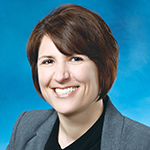
Uliana
Stephanie Uliana is an Ascension community benefit manager focused on Ascension St. Vincent's Indiana market. Pre-pandemic, a key aim of her department was increasing Indiana schoolkids' access to free meals in schools, including by expanding the availability of school breakfasts. (See related Catholic Health World coverage.)
When the pandemic hit and schools discontinued or sharply curtailed in-person learning, Uliana and her community benefit colleagues in the region talked with each of the 16 hospitals Ascension operates in Indiana as well as with food aid organizations and schools Ascension had partnered with in its prior work to address food insecurity. They also talked with a statewide coalition focused on school breakfast.
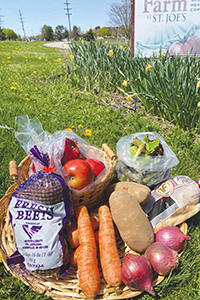
Some of the produce grown at the Farm at St. Joe's goes to people who are poor and vulnerable. That farm is operated by Saint Joseph Mercy Health System.
New approaches
The conversations revealed that there was a need to expand the scope of food aid work. Community members who already were food insecure before the pandemic's onset were hit hard financially by coronavirus-related business shutdowns and scale-backs. Low-income community members with kids were having trouble feeding their children — with schools closed, there initially were no free breakfasts or lunches. In Indiana the percentage of children living in food-insecure households has increased from 17.5% in 2018, to a projected 25.3% for 2020, according to information from Feeding America.
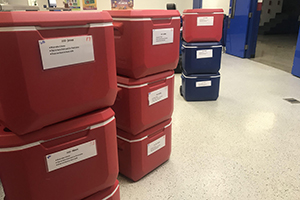
Ascension St. Vincent's Indiana market community benefit teams assisted local schools in pivoting to new ways of getting food to students during the pandemic. The system's Salem, Indiana, location bought 24 of these coolers so a school could store breakfasts and transport them to classrooms.
The community benefit representatives' conversations also revealed that the schools' food service directors were grappling with how to get free meals to kids outside of the school venue.
Uliana says Ascension listened to the schools to understand the challenges they were facing in getting food to kids, and then tried to assist them in addressing those challenges. For instance, one Ascension hospital purchased equipment that enabled a school to get hot, nutritious meals to kids who were learning remotely.
Workarounds
Jaime Dircksen is vice president of Community Health and Well-Being at Livonia, Michigan-based Trinity Health, and Amanda Sweetman is regional director of farming and healthy lifestyles for Trinity Health in Michigan. Dircksen says during the pandemic Trinity Health markets have registered a significant increase in need for food aid. The markets reported that the traditional emergency food system — particularly walk-in food pantries — were struggling to meet the demand.

Dirksen
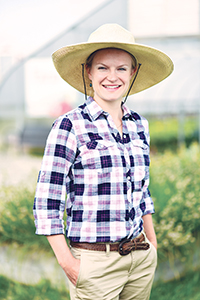
Amanda Sweetman, regional director of farming and healthy lifestyles for Trinity Health in Michigan, works to ensure vulnerable populations can access healthy produce.
Meals on Wheels could not rely on its large corps of older adult volunteers to make deliveries for fear of exposing them to contagion risk. Soup kitchens and churches that provided food aid had to close amid lockdowns. Dircksen says Trinity Health hospitals helped their food aid partners to pivot to new models and workarounds to safely deliver food. For instance, they assisted walk-in pantries in finding ways to reduce personal contact in the handoff of food, such as through drive-thru lanes staffed by employees or volunteers in personal protective gear.
Dircksen notes that local philanthropy has increased during the pandemic and that has enabled organizations that address food insecurity to buy more food and feed more people.
Trinity Health's Sweetman coordinates food aid efforts by small Ann Arbor, Michigan-area farms, including a farm associated with Saint Joseph Mercy Health System. (See related Catholic Health World coverage.) Prior to the pandemic, the work involved getting fresh fruits and vegetables from the farms to hospital staff and patients, as well as to low-income community members. With the onset of the pandemic, Sweetman and her farm community partners sought ways to get the produce to newly food-insecure people. This included arranging for delivery of produce to homebound people who are patients of Saint Joseph physicians.
Ascension employs digital tool to assess, address the complexities of food insecurity
A year ago, Ascension put a tool into use systemwide that it had found useful in one of its markets for assessing and responding to community need. That tool is helping Ascension to learn in an in-depth and ongoing way about food insecurity in each of the communities it serves, including among associates. Ascension markets are using that information to adapt and focus their work with partnering organizations to address hunger in their communities.
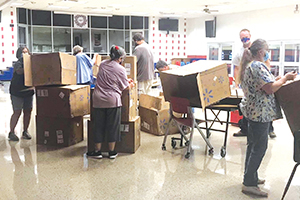
Workers unpack coolers purchased by Ascension St. Vincent Salem in Indiana for use in a school breakfast program.
Mary Paul is Ascension vice president of mission integration. She said the Social Response Framework tool is a digital network that Ascension developed to gather intelligence from its local markets. It provides "a systematic process to listen, track barriers, organize learnings and develop responses that are tailored to the needs of the community."
"This process enables us to go beyond the initial concern, to develop a response that reflects the complexity of the social condition," Paul said.
To use the tool, leadership records top community needs in a real-time manner. During the pandemic, food insecurity was identified as the top shared need. Then Ascension asked its community benefit representatives systemwide to gather insights through conversation with internal and external contacts and then log that information into this centralized tool. That intelligence is informing Ascension's efforts to develop market-specific anti-hunger initiatives in collaboration with its local social service partners.
Ascension developed the tool in its Wisconsin market to understand the reasons vulnerable expectant mothers were missing prenatal care appointments and design responses. One of these responses was the creation of a child waiting area where children are supervised during prenatal appointments. Another was the introduction of food boxes tailored to the nutrition requirements and medical conditions of expectant moms.
When the pandemic shut down local economies, Paul said, Ascension leadership recognized the value of the tool for gathering information efficiently from around the system.
Leadership in Ascension markets had said that food insecurity was the top socioeconomic issue arising locally at the start of the pandemic. Paul said through the tool, Ascension learned that the number of people requiring food aid has expanded greatly, that food insecurity is very complex and that one strategy will not work across the system.
"Our solutions and responses are built in and with our community, one conversation at a time," Paul said.
Paul said Ascension now is finalizing plans for a healthy food initiative to respond to both associate and community food insecurity. This initiative will be a broad approach that each market will be able to tailor to address its specific circumstances.
— JULIE MINDA